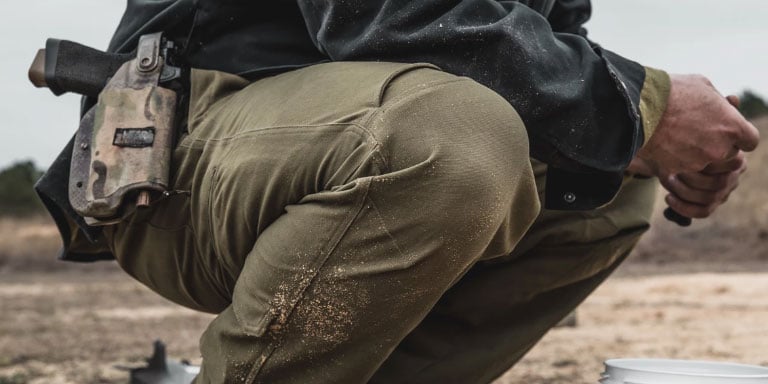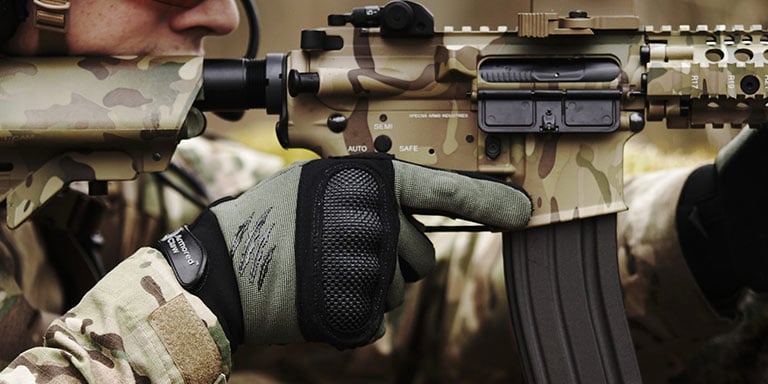
Military operatives, hunters and hobbyists all use night vision gear for a variety of reasons. If you're likely to use night vision in the military, you've probably already been trained on the basics, but knowing more about how it works could help you use it more effectively.
In this guide, we'll introduce the various types of night vision and thermal vision gear, explain how they work and explore the various aspects you'll need to understand if you're considering purchasing your own. We'll also review the pros and cons of night and thermal vision across various applications.
Types of Night Vision Devices
Like most other kinds of specialized equipment, not all night vision devices are created equal. Knowing the basic differences between them will help you make an informed buying decision, or if you've been issued night vision gear by the military, it helps to know its relative strengths and weaknesses.
Analog versus Digital Night Vision
First of all, you should know (if you don't already) that night vision and thermal vision aren't the same thing, but it can be easy to confuse them. Night vision gear amplifies light whereas thermal vision detects heat signatures (more on thermal gear later).
Analog Night Vision

The most basic distinction between night vision devices lies in whether they're analog or digital. The technical differences are myriad and complicated, and as a general user, you don't really need to know them. As of 2020, analog devices are more or less on their way out, but they're usually a lot less expensive than digital models, making them a solid choice if you're just looking to get familiar with night vision without spending too much money.
Analog devices render images in shades of green and black. Why green? The human eye can distinguish shades of green more easily than those of any other color. Mechanically speaking, analog devices are simpler than their digital counterparts and they don't use software, making them less prone to failure — although they're more fragile and so more susceptible to physical damage.
Digital Night Vision
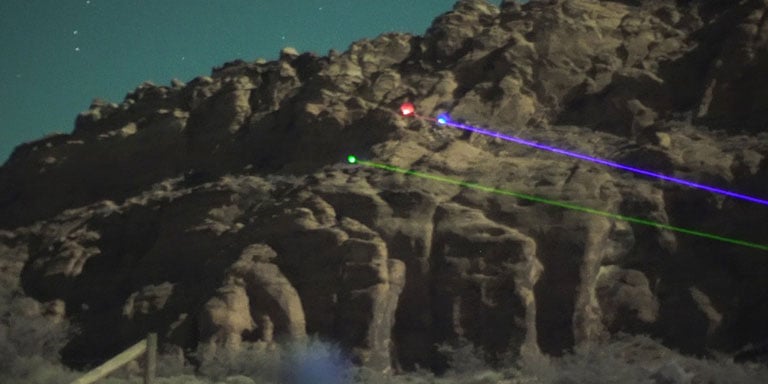
This image was captured in complete darkness. Digital night vision provides both light and color to the user's field of vision.
In a nutshell, digital night vision can do a lot more. Mid-range and high-end models can produce color images, capture video, and support heads-up display (HUD) overlays. Some of these advanced features require software or firmware, which introduces more potential failure points.
As of this writing, digital night vision batteries are, on the whole, still slightly inferior to their analog counterparts in terms of cost and longevity. The hardware has to work a lot harder to produce clearer, more colorful images, which requires more power. Still, analog night vision technology is no longer being actively developed, whereas digital technology is just getting started. It won't be long before digital power sources catch up to and surpass their predecessors.
Infrared Amplification
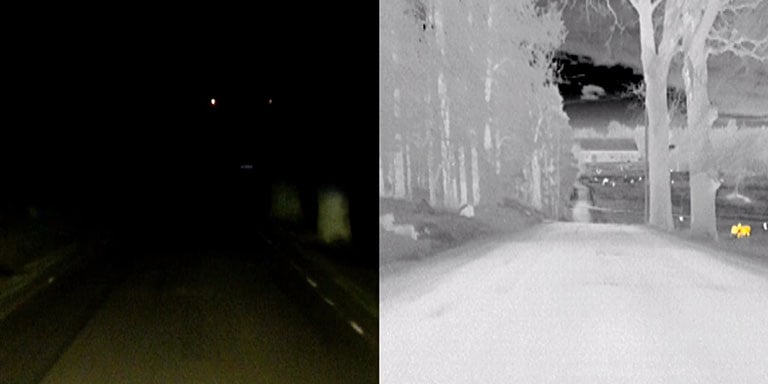
Infrared (IR) light is a type of light not visible to the naked eye. Some people erroneously use "infrared" and "thermal" interchangeably, but these terms describe different things. In the context of night vision applications, IR amplification helps the equipment work better.
Night vision devices work by amplifying light, so there must be at least some light to amplify; they don't work in total darkness. IR amplification devices emit a "bright" beam of invisible light that gives the night vision device more light to amplify, resulting in a brighter, clearer image.
Some manufacturers of firearm accessories make IR lasers that are only visible with the aid of night vision — great for night shooters who don't want their lasers to give them away.
Thermal Vision
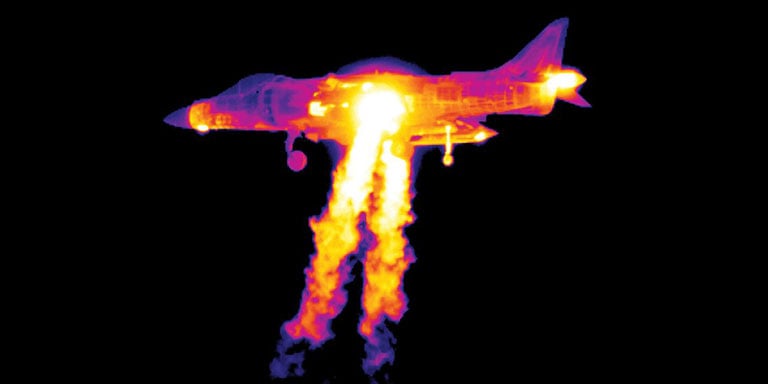
Unlike night vision, thermal vision doesn't require any light at all. Some devices render images in black and white, with darker shades of black representing more intense sources of heat. Objects appearing gray or white are emitting little or no heat. On some models, this setting can be inverted.
Other thermal devices show images in rainbow hues, with heat-emitting objects appearing red, orange or yellow. Cooler objects appear blue, purple or green. Typically, these devices are more useful when the user needs the ability to determine temperature ranges with precision. Black-and-white models render images with greater clarity, making them the preferred choice for simply distinguishing people and animals from the rest of the environment.
Tactical Pros and Cons of Thermal and Night Vision
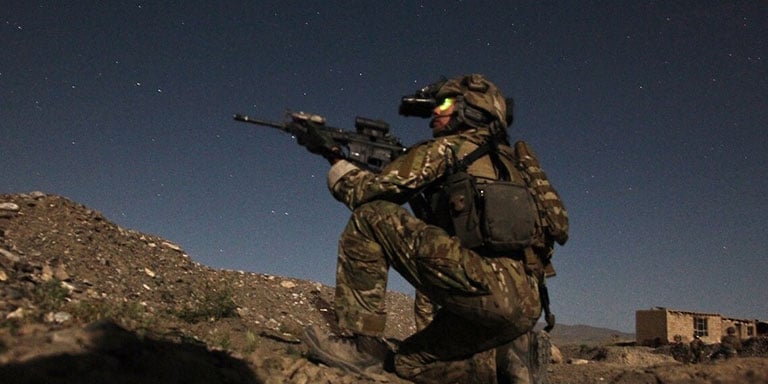
If we were to simply list the pros and cons of night and thermal-vision devices, it would appear to be a pretty unbalanced list. They're good only for increasing the visibility of your environment, targets and allies without increasing your own, but in many situations, that's a huge advantage — often significant enough to outweigh the numerous drawbacks.
Night and thermal-vision devices are expensive and delicate, making them vulnerable to damage, especially in rough outdoor conditions. Details such as faces and lettering may be hard to make out, even with high-end digital models, and users risk temporary blindness if the night-vision device is suddenly flooded with bright light (this isn't a concern with thermal devices).
Less obviously, but arguably most importantly, most tasks require extra training once night vision enters the equation. Such devices alter your depth perception and field of view significantly enough to make even routine tasks challenging without practice. Novice users often struggle to open doors because their hands aren't exactly where they appear to be, so you can imagine that more complex tasks like running and shooting would be even trickier.
Even in light of the numerous hindrances associated with night and thermal vision, the ability to see without being seen is tremendously advantageous in certain situations. Just make sure you train and practice regularly to maintain comfort and competence with your equipment.
Night Vision Buying Guide
If you're in the market to buy a night-vision device of your own, know that certain features and models are better suited to certain purposes. Whether you're hunting, shooting or practicing your nighttime photography, there's a device made for you.
Types of Devices
Most night-vision devices are binoculars, monoculars or rifle scopes, although more specialized devices such as camera lenses do exist. Each has distinct advantages and disadvantages.
Night Vision Monoculars
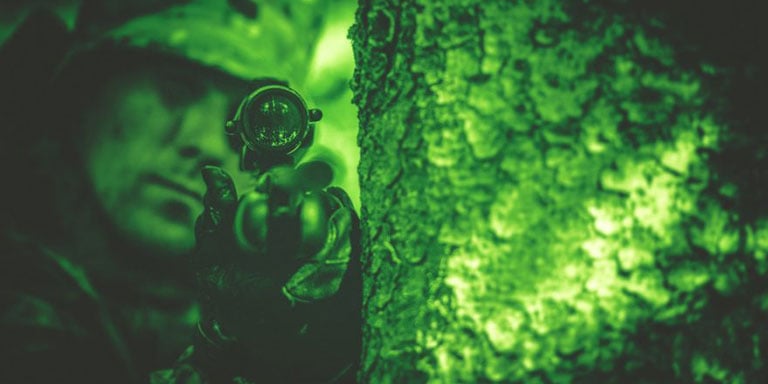
Monoculars are ideal for keeping one eye adjusted to the actual lighting conditions, which can help your senses of balance, equilibrium, and proprioception (the sense of where your body is relative to other objects). It also makes you less susceptible to sudden flashes of bright light because only one eye will be temporarily blinded. This blindness usually lasts only a few seconds, but that could be a long time in a life-or-death situation.
Night Vision Binoculars
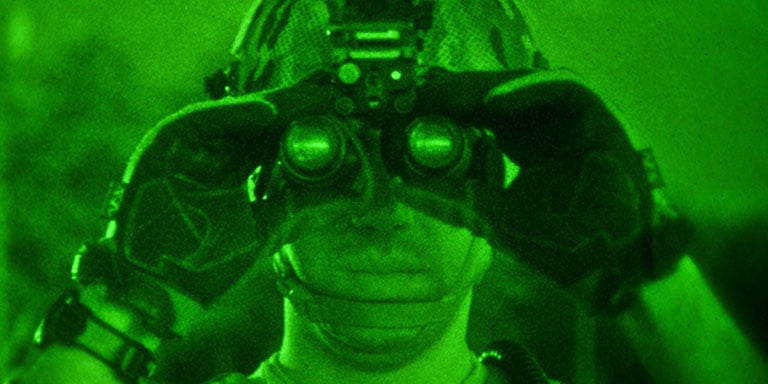
Binoculars typically offer better range and image clarity than monoculars at comparable price points, and they're less disorienting, particularly for inexperienced users. Shooting is generally easier with binoculars if you're not using sights and accessories designed for use with night-vision devices (if you are, monoculars aren't too much more difficult to use).
Night Vision Scopes
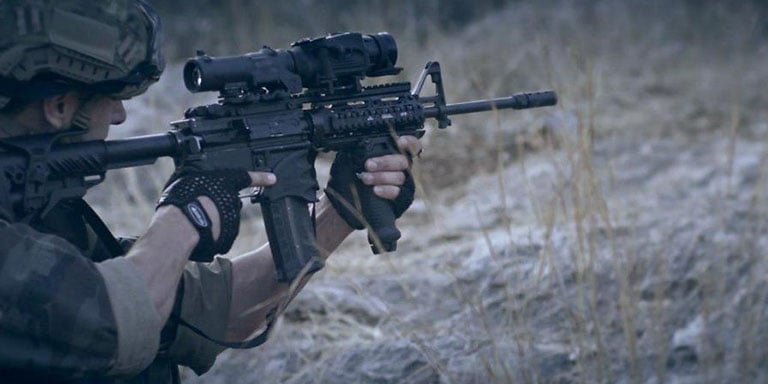
Night-vision and thermal scopes are ideal if you only need image enhancement when you're ready to take a shot. Because the image-enhancing technology is integrated directly into the scope, you won't have the disorientation associated with monoculars and binoculars. You also won't need to spend extra money on specialized sights or lasers that would otherwise be necessary (or at least helpful).
Resolution
When we're talking about pixels, resolution is the degree to which one pixel is easily distinguishable from those around it. High-resolution night-vision devices produce sharper, clearer images, but they cost more — sometimes a lot more — than entry-level models.
Range
Most mid-range night vision devices have a range of about 200-300 yards. This range refers to the distance at which you can distinguish objects with roughly the same degree of clarity that you would be able to discern with the naked eye in bright daylight. You can get devices that work well beyond 300 yards, but they cost a lot more.
Range has a complicated relationship with resolution. Images can be hard to make out because of insufficient light, inadequate amplification, poor resolution or any combination thereof. In order to see clearly at 200 or 300 yards, you'll need a device that doesn't bottleneck itself with respect to either distance or image quality.
Magnification
If you need to see clearly beyond 300 yards, it'll likely be more cost-effective to choose a device with a high-quality digital zoom function. Bear in mind that zooming in drastically narrows your field of view and makes it much easier to lose track of moving targets.
Field of View
If you envision yourself at the center of a circle, field of view describes how much of it you can see. Normally, your field of view is a little less than 180 degrees. When you look through binoculars or a scope, your field of view is reduced because you can no longer see as far to either side.
Some night vision devices limit your field of view more than others. If you use a device with a zoom feature, your field of view will be drastically limited while zoomed in. Consider whether the need to see far is worth sacrificing most of your peripheral vision.
Spectrum

There are many different frequencies and wavelengths of light. The human eye, unaided, can detect only a small fraction of them — those called "visible light" on the electromagnetic spectrum. Cheap night vision devices have similar limitations, whereas high-end models can "translate" light that normally isn't visible into light that is. Remember the IR amplification feature? You won't find it on bargain-bin night vision goggles. Devices that can make use of IR or UV (ultraviolet) light will be more useful in a broader range of situations.
Luminous Gain
If you'll be working in exceptionally dark environments, look for night vision gear with high luminous gain, which describes the device's ability to amplify very low light levels. Some night vision experts consider a gain number of 60,000 to be the dividing line between high and low-quality units (bigger numbers are better).
Equivalent Background Illumination (EBI)
EBI describes how well the device can form a crisp, clear image in dark areas. It's related to but separate from luminous gain. EBI is especially important for stargazing and for hunting or shooting on pitch-black nights. Also note that EBI is negatively affected by warm temperatures and positively affected by cold temperatures.
Signal to Noise Ratio (SNR)
SNR is another measure of image quality. Devices with low SNR ratings (under 25) produce images with more static or scintillation.
Bloom
If you'll be using night vision in urban or suburban areas, look for a device with low bloom. This describes the size of the halos you'll see around bright light sources. Large halos (over 1.0) can dramatically obscure overall image clarity and can even "hide" people or animals.
Battery
In general, night vision devices that produce brighter, clearer images need more power to do so. Features like video recording and image colorization also drain batteries quickly. If extended battery life is important to you, you may have to forego some of these fancier features.
Durability
The inner workings of both analog and digital night vision devices are very delicate; a single component being broken or knocked loose can render the device ineffective or inoperable. At lower price points, the technology itself is most of what you're paying for, and the unit is likely to be especially fragile. If you plan to use night vision outdoors or for critically important tasks, it's worth investing in a device with an extra-durable casing and interior reinforcements.
Weather Resistance
Although extra-durable night-vision devices tend to be more resistant to water, mud and extreme temperatures, that isn't always the case. Be sure to review the product specifications carefully if you'll be using night vision in inclement weather.
Which Devices Are Best for You?

Many people use night vision, including hunters, photographers, pilots and military personnel. If you're in a position to buy or request your own night vision equipment, narrow down your list of candidates by prioritizing the features and capabilities you need most.
- Shooters, hunters and military operatives generally should prioritize high resolution, low bloom, good battery life, high durability and weather resistance. Range, zoom, field of view, spectrum, EBI and luminous gain may also be important, depending on your exact needs.
- Pilots and photographers need high resolution, good range and low SNR. Low bloom is also helpful.
- Stargazers should look for night vision gear with excellent EBI and luminous gain specs.
Night vision is a hobby (and skill) in and of itself, and we've only scratched the surface regarding what it can do; people have written entire books on the subject. Hopefully, this guide will serve as a helpful starting point if you're ready to venture into the world of night vision.
Did you find this article helpful?



